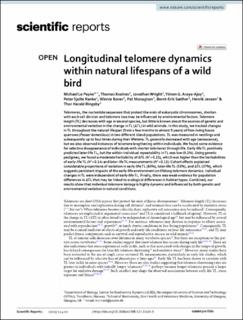| dc.contributor.author | Pepke, Michael Le | |
| dc.contributor.author | Kvalnes, Thomas | |
| dc.contributor.author | Wright, Jonathan | |
| dc.contributor.author | Araya Ajoy, Yimen Gerardo | |
| dc.contributor.author | Ranke, Peter Sjolte | |
| dc.contributor.author | Boner, Winnie | |
| dc.contributor.author | Monaghan, Pat | |
| dc.contributor.author | Sæther, Bernt-Erik | |
| dc.contributor.author | Jensen, Henrik | |
| dc.contributor.author | Ringsby, Thor Harald | |
| dc.date.accessioned | 2023-10-24T09:13:27Z | |
| dc.date.available | 2023-10-24T09:13:27Z | |
| dc.date.created | 2023-03-21T10:27:31Z | |
| dc.date.issued | 2023 | |
| dc.identifier.issn | 2045-2322 | |
| dc.identifier.uri | https://hdl.handle.net/11250/3098294 | |
| dc.description.abstract | Telomeres, the nucleotide sequences that protect the ends of eukaryotic chromosomes, shorten with each cell division and telomere loss may be influenced by environmental factors. Telomere length (TL) decreases with age in several species, but little is known about the sources of genetic and environmental variation in the change in TL (ΔTL) in wild animals. In this study, we tracked changes in TL throughout the natural lifespan (from a few months to almost 9 years) of free-living house sparrows (Passer domesticus) in two different island populations. TL was measured in nestlings and subsequently up to four times during their lifetime. TL generally decreased with age (senescence), but we also observed instances of telomere lengthening within individuals. We found some evidence for selective disappearance of individuals with shorter telomeres through life. Early-life TL positively predicted later-life TL, but the within-individual repeatability in TL was low (9.2%). Using genetic pedigrees, we found a moderate heritability of ΔTL (h2 = 0.21), which was higher than the heritabilities of early-life TL (h2 = 0.14) and later-life TL measurements (h2 = 0.15). Cohort effects explained considerable proportions of variation in early-life TL (60%), later-life TL (53%), and ΔTL (37%), which suggests persistent impacts of the early-life environment on lifelong telomere dynamics. Individual changes in TL were independent of early-life TL. Finally, there was weak evidence for population differences in ΔTL that may be linked to ecological differences in habitat types. Combined, our results show that individual telomere biology is highly dynamic and influenced by both genetic and environmental variation in natural conditions. | en_US |
| dc.description.abstract | Longitudinal telomere dynamics within natural lifespans of a wild bird | en_US |
| dc.language.iso | eng | en_US |
| dc.publisher | Springer Nature | en_US |
| dc.rights | Navngivelse 4.0 Internasjonal | * |
| dc.rights.uri | http://creativecommons.org/licenses/by/4.0/deed.no | * |
| dc.title | Longitudinal telomere dynamics within natural lifespans of a wild bird | en_US |
| dc.title.alternative | Longitudinal telomere dynamics within natural lifespans of a wild bird | en_US |
| dc.type | Peer reviewed | en_US |
| dc.type | Journal article | en_US |
| dc.description.version | publishedVersion | en_US |
| dc.source.volume | 13 | en_US |
| dc.source.journal | Scientific Reports | en_US |
| dc.source.issue | 1 | en_US |
| dc.identifier.doi | 10.1038/s41598-023-31435-9 | |
| dc.identifier.cristin | 2135623 | |
| dc.relation.project | Norges forskningsråd: 274930 | en_US |
| dc.relation.project | Norges forskningsråd: 223257 | en_US |
| dc.source.articlenumber | 4272 | en_US |
| cristin.ispublished | true | |
| cristin.fulltext | original | |
| cristin.qualitycode | 1 | |

